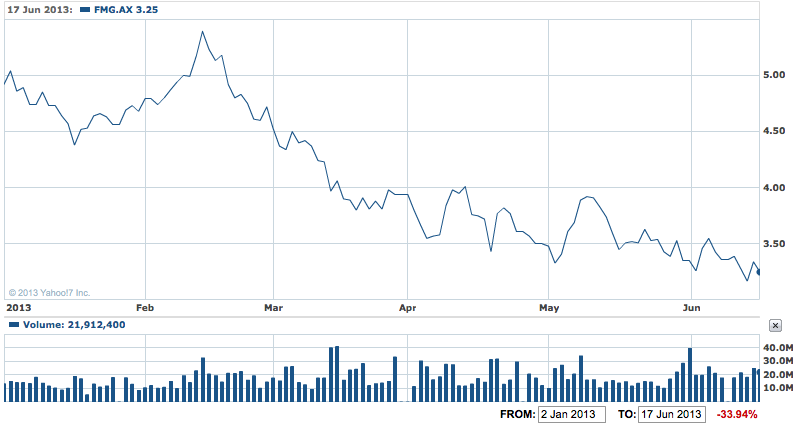A combination of a weak stock market, the worse than expected early figures from the monthly survey of Chinese manufacturing and a surprising downgrade of its iron ore production target for 2012-13 saw shares in Fortescue Metals Group sold off sharply yesterday.
The shares fell 6.5% or 21c to $3.13. That was more than three times the drop in the wider market.
FMG YTD – Delay in asset sale hits FMG

Fortescue said in statement that it will miss its iron ore sales target for the 2013 financial year by around 5% and has also delayed the timing of a sale of its infrastructure assets by at least three months.
The company said it was looking at selling between 80 and 82 million tonnes this financial year, instead of the forecast 82 and 84 million tonnes. That’s a shortfall of around 4.75% and is due to the wet weather in the Pilbara this month.
It said it expects to boost sales in 2014 to a range of 127 to 133 million tonnes, an increase of well over 50%.
That in turn means the targeted 155 million tonnes a year annual rate won’t be reached until 2015.
CEO Nev Power said in the statement that the company is still in cost cutting mode, the results of which will show up in 2014.
Spending on its rapid expansion plan to an annual sales figure of around 155 million tonnes is almost complete and the company said yesterday that free cash flow would soon increase dramatically to help pay down its $US10 billion debt pile.
"Strong demand for iron ore and pricing within Fortescue’s expected range (US$110 to US$130 per dry metric tonne 62% Fe index price) underpin solid quarterly revenues," Mr Power said.
"The impact of a strong production performance and price consistency along with lower costs and declining capital expenditure, see Fortescue’s expected cash balance at 30 June 2013 between US$1.7 billion and US$2.0 billion," he said in the statement.
World iron ore prices have recovered a bit in the past three weeks and traded around the $US120 a tonne level on the spot market this week – up some $US 10 a tonne. That’s despite price cuts on steel products by Chinese mills and reports of containing weak demand for products. Chinese iron ore imports in May were the third highest on record at more than 67 million tonnes.
After the shock late last year when iron ore prices crashed, forcing Fortescue to start cost cutting and asset sales, the company said yesterday that it "is now in a phase of significant cost reduction and continues to focus on operational efficiencies which will see it moving down the global cost curve".
"Capital expenditure for FY2014 is expected to be US$1.9 billion representing a significant decrease on FY2013 following the completion of the T155 expansion project. Estimated capital expenditure for 2013 is US$6.3 billion, in line with guidance.
"The reduced capital investment and increase in production provides further free cash generation," the company said.
The major part of its debt reduction strategy is the sale of a stake in its rail and port assets which was expected to be completed this month. But Fortescue told the market yesterday that it would now occur some time in the three months ending September.
"Fortescue is not under pressure to conclude a sale of an interest in its rail and port assets. However the level of interest generated has necessitated a longer period of evaluation than previously contemplated," Mr Power said in the statement.
"On the basis of significant shareholder value being released by de-gearing of the company’s balance sheet, a sale will only occur for fair market value, and on the basis that the current efficiency of infrastructure and mining operations are not impacted.
"The sale process is now substantially advanced. The process is progressing well and in accordance with expectations. Based on the current status, if sanctioned, any transaction is likely to be announced in the September 2013 quarter."













